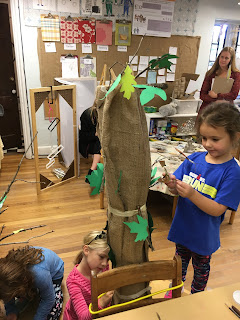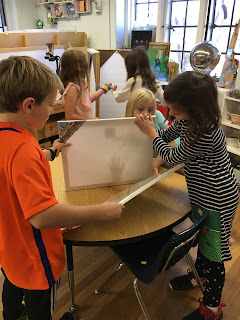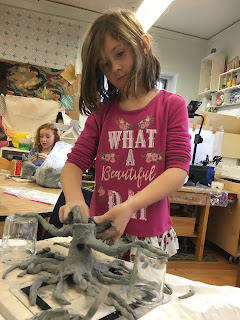9/18/17 After hearing that the umbrella project
would be about listening, the second graders went outside to see and sketch what they could hear. Mostly what everyone heard was first graders running around at recess and preschoolers going to the cottage for aftercare. Someone asked "I wonder if the waiting tree can hear children's footsteps when they are running around it?" This was the question teachers brought back the next day at circle.
would be about listening, the second graders went outside to see and sketch what they could hear. Mostly what everyone heard was first graders running around at recess and preschoolers going to the cottage for aftercare. Someone asked "I wonder if the waiting tree can hear children's footsteps when they are running around it?" This was the question teachers brought back the next day at circle.

Everyone was interested in finding out if trees could hear. Did they also make sounds? We didn't know. Children used tools and inventions to see if they could find out.


We all spent some time listening to trees. We looked at National Geographic (wisdom-of-trees), the work of artist Alex Metcalf (metcalf installation) and of David George Haskell (dghaskell), a scientist who listens to trees. Reading about a tropical tree that responds to the sound of waves, and also a network of clone trees in Colorado, led to the theory that trees must 'hold hands under the ground". Do their leaves also hold hands? In Scientific American, we learned Mr. Haskell hears;
"Clicks and rasps under the bark: Beetle larvae auger the tree with jut-bladed mouths. The young insects swallow the fine sawdust, passing it to guts populated by symbiotic microbes. Woodpeckers listen, hoping to catch a sound that betrays an insect’s presence in the tree. Pressing my ear to the tree, I hear the wood-carried sound of beetle mouth and bird beak. In the canopy, caterpillars chew on leaves. The tree, too, listens. When the sounds of munching caterpillars are played to a tree, the plant releases defensive chemicals."
Another scientist said he used a sensor like a guitar pick-up to record the sounds inside trees. I wired a few of those and we tried amplifying the sounds, but no clicking was apparent. After a lot of work no one was sure they had heard a tree clicking or talking. Hoping to help, Teachers reminded everyone of a theory from earlier- that the forest might hush when people are about. Could disguising yourself as a forest creature or plant let you hear more sounds? The children decided to test this theory by making disguises.
..and went outside to listen.


The class also took a trip to the botanical gardens to learn more about trees. Finally it was time for second grade to show their learning. One group worked with me in the studio to make a sculpture that shows tree communication.






















Your students' work is really inspiring! I teach preschool, but I definitely think my students would love to engage in experimentation of this sort as our most recent of unit of study was trees. I love that your students created disguises to see whether or not the forest would make noises without people around. That's such an interesting way to test out a theory. Your students seem to be so creative and such critical thinkers. How do you promote that in your classroom?
ReplyDelete